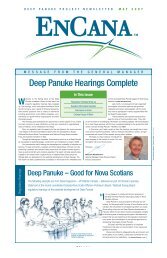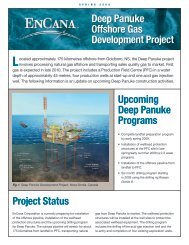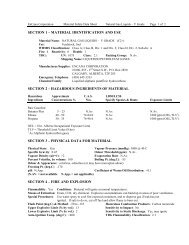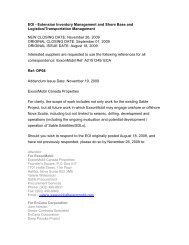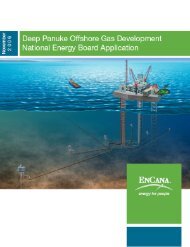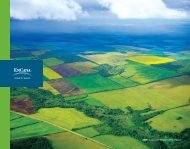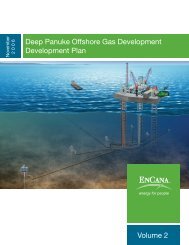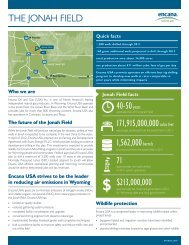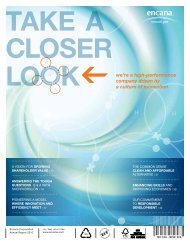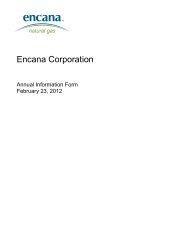Deep Panuke Project Description - Encana
Deep Panuke Project Description - Encana
Deep Panuke Project Description - Encana
Create successful ePaper yourself
Turn your PDF publications into a flip-book with our unique Google optimized e-Paper software.
2.10.2.11 Export Pipeline AlternativesThere are two alternatives for the export pipeline. EnCana proposes to transport product for sale via asubsea pipeline from the offshore processing facility to one of two delivery points:· Goldboro, Nova Scotia (M&NP Option); or· SOEP 660 mm [26 inch] pipeline tie-in (SOEP Subsea Option).Both export pipeline alternatives are technically feasible and routes have been chosen to minimizeenvironmental impact. The selected alternative will be determined pending the outcome of commercialdiscussions between the operator of SOEP, ExxonMobil, and EnCana.2.10.2.12 Subsea Tie-back AlternativesThe <strong>Deep</strong> <strong>Panuke</strong> reservoir areal extent has changed substantially from the 2002 <strong>Project</strong> basis of onelicense, PL2902, to the current <strong>Project</strong> basis covering PL2902, EL2387, SDL2255H, PL2901 andEL2360. The pool size estimate requires a minimum of five production wells for the P90 case (value at90 th Percentile) and a maximum of eight production wells for the P10 case (value at 10 th Percentile) toeffectively deplete the resources. The large extent of the pool necessitates the use of a subsea solution.The <strong>Project</strong> plans to utilize four suspended wells from the exploration drilling program as productionwells which allows for reduced capital costs and environmental interactions. One new production wellwill be drilled for the <strong>Project</strong> start-up. Up to three additional production wells could be drilled in future.A subsea tie-back study was carried out to determine the optimal method of tying in the wells to thefield centre. It should be noted that a new acid gas injection well must also be tied back to the fieldcentre; however, the geology in the area allows numerous options for the location of this well so thiswas not considered as a driver for the lay-out study.From a layout consideration, it was determined that a tie-back of individual wells to the field centre wasthe best technical solution. The proposed well locations do not suit a template or manifold arrangement.The field centre location was determined by minimizing the tie-back lengths of the wells to lower capitalcosts and improve flow assurance.Three alternative methods for flowline installation were considered: 1) “S-lay” barge method; 2) “reellay” technique; and 3) flexible flowline method. The “S-lay” lay barge method involves the use of anoffshore barge to weld and then lay lengths of rigid pipe on the seabed by means of a “stinger”overhanging the stern of the barge. Subsequently, the pipe is trenched using a subsea trenching orploughing spread. The “reel lay” method involves pre-welding rigid pipe lengths together at aspecialized “spool base” onshore and then reeling the entire flowline onto a large diameter reel. The reel<strong>Deep</strong> <strong>Panuke</strong> Volume 4 (Environmental Assessment Report) · November 2006 2-79




